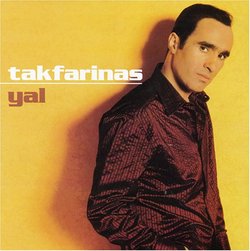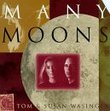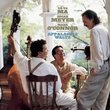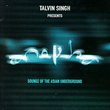| All Artists: Takfarinas Title: Yal Members Wishing: 0 Total Copies: 0 Label: Tinder Original Release Date: 6/13/2000 Re-Release Date: 6/27/2000 Genres: International Music, Pop Styles: Africa, Middle East, Turkey Number of Discs: 1 SwapaCD Credits: 1 UPC: 789428595823 |
Search - Takfarinas :: Yal
 | Takfarinas Yal Genres: International Music, Pop
New Album from Al;gerian Poet Takfarinas who Sold Two Millions Albums of his Previous Album. He Mixes Traditional Kabyle Music with Hispanic, African, Indian Traditional Music. |
Larger Image |
CD DetailsSynopsis
Album Details New Album from Al;gerian Poet Takfarinas who Sold Two Millions Albums of his Previous Album. He Mixes Traditional Kabyle Music with Hispanic, African, Indian Traditional Music. Similarly Requested CDs
|
CD ReviewsBerber Beats Surface From Beneath Arabization of Algeria Mitch Ritter | Po' Land, Or-Wa USA | 12/15/2000 (4 out of 5 stars) "The Berbers, or the Amazigh People (singular) or the Imazighen (plural meaning Free People) as they call themselves, are the native peoples of North Africa. Yal Music was due to surface from Algeria or Morocco or other North African nations, despite attempts by the post-colonial Arabization program to deny the Amazigh-Berber language of Tamazight a place in the Arabized society.But Takfarinas' take on Yal music, the syllabic riffing on Tamazight (not Arabic) lyrics and polyrhythms, brings the Berber Beats up from the underground and onto the world stage, where this pluralistic culture trapped in linguistic, cultural, and human rights suppression, truly belongs. CMJ-NMR (College Music Journal-New Music Review) also mistook Takfarinas for Arabic. Be clear about this marvelously sung language of Tamazight. Unlike Arabic or any other known alphabet (or Al Abjadiya in Arabic), the Berber's Tamazight language has 39 letters, and many unique and original soundings that can give an Anglo listener a buzz just listening to it. The sunny vocal acrobatics on "Tanoumi" showcase Takfarinas' musicality in a North African form of scat singing. The multi-tracked instrumentation, led by Takfarinas' doublenecked electric mondol (Amazigh lute, or 10-silk stringed mandolin), and Mediterranean percussive palette, also will not likely be mistaken for Arabic music or dreary Algerian rai.The Amazigh-Berbers have a much older and more open civilization in North Africa than its most recent conquerors and occupiers, the Arabs. Going back in history, the Berbers have withstood onslaughts by the Vandals, the Greeks, the Romans, the Arabs, the Turkish Muslim Caliphate, the Spanish Catholic Inquisition, the French Foreign Legion, and after joining with their similarly oppressed Arab brethren, the Amazigh-Berbers were able to expel the French in 1962. However, following the revolution, the Arabs quickly moved to consolidate multi-lingual and multi-ethnic Algeria (Spanish was used as well as French, while the majority population spoke Tamazight)in an Arabization campaign championed by Pan-Arabist expansionists such as Egypt's leader Gamal Abd-El Nasser. The Amazigh-Berbers who had since antiquity inhabited the coastal ranges along the Mediterranean, were forced further and further into Algeria's massive interior, almost to the Sahara desert (where the Tuarig tribes conveniently speak and trade in the Tamazight language, having resisted earlier Arabic waves).Takfarinas' music is a celebration of what is intrinsically Tamazghan (North African), with the vivid elements of those Mediterranean cultures it mingled, intermarried, and traded with. In addition to the infectious upbeat "Zaama Zaama" Takfarinas closes his otherwise joyous album with an elegaic memorial to Amazigh-Berber bard and linguistic & cultural freedom fighter, Lounes Matoub. Matoub was gunned down in the heart of his Kabylian homeland in a car along with his wife and sister-in-law who survived the attack. Matoub had dared to return to Algeria after many years living, writing, and recording in his outlawed language of Tamazight from abroad. His final album was irreverently subtitled ALGERIASSIC PARK, as with scathing humor and wise wit Matoub actively worked to have the Arabization Laws reformed to allow for the use of his people's native language in recording, publishing, theater, schools, broadcast outlets, and the legal court system where translation from the official Arabic was forbidden. Takfarinas' lyrical eulogy to Matoub is presented with translation into French in the CD booklet, but I agree with the reviewers from Annapolis Maryland and the Hawaiian Islands who lamented this lost opportunity at informing the Anglo world of Takfarinas' salty and poetic observations of life in North Africa.Takfarinas is in a long line of great Amazigh-Berber recording artists. Also worth checking out (if only to hear how different the Amazigh-Berber musical flavors can be, even while maintaining their "Berberitude") are the CD's by Ferhat, Houria Aicha, Djur Djura (poetess Djourah Abouda's ensemble based in France), Slimane Azem, Lounes Ait Menguellet, and the awesome Djamel Allam from the Berber Spring generation. Younger and edgier, or more experimental musical artists such as Tayfa, the liberated women's duo-led tribal beat band Iness Mezell, Rabah Asma, and California-based studio exiles Umalu (Space Age Berber Music) and Moh Alileche (traditional Amazigh Ensemble that crosses many borders) all merit attention. Takfarinas and these folks have brought an ancient and diverse culture into the 21st Century with an ease that few on the World Music scene have attained." Amazigh at its best Arielle | Toronto, CA | 09/19/2001 (5 out of 5 stars) "Like all indigenous people worldwide, the Amazigh population of North Africa has resurfaced as a people, claiming their rights as individuals and the freedom to cultivate their cultures as others do. The Amazigh range in skin colour from black (the Tuareg) to light-brown to white and are found across North Africa including Libya, Morocco, Algeria, Tunisia, Egypt, and Mali. They are not classified by race but rather by linguistics therefore cannot be classified simply as caucasian. In any case, they are the suppressed people of North Africa, similar to those minorities found in North America and aboriginals found in Australia. They seek separatism such as the french-speaking peoples of Canada do because their right to express themselves as a culture has, for the longest time, been denied. Here now from this heartache, has arised, the new "prince" of Amazigh sound by the name of Takfarinas. Like his counterpart Matoub Lounes, this handsome prince uses the magnetic rapture of music to give us all the power of his culture including of course the enigmatic sound of Amazigh language, an alphabet containing 36 letters. I have been deeply interested in Amazigh culture upon meeting my closest friend, a native of the Kabylia region of Algeria. I have ever since been enraptured by such a culture and Takfarinas, lo and behold was the first of Amazigh CDs I came across. A pure and genuine sound, Takfarinas, has a beautiful voice that is sure to transcend the ages and keep the power of Amazigh culture alive through song. A culture, that for too long has been denied and must be given to the world stage at long last. This album is simply magical and riveting. Every song flows with melody and lyrics that astound the ear; such a weaving of contemporary and traditional sound has never been accomplished quite so well as Takfarinas has done. A CD worth every cent and a definite favorite of mine. Amazigh resurfaces once more and the prince of Amazigh music takes sweeps us once again with a powerful ensemble and catchy lyrics as well as hip dance beats. This is music at its best." Takfarinas has a new fan! Jasmine Kalina | Hawaii, USA | 11/01/2000 (5 out of 5 stars) "I rarely find a CD that I enjoy listening to in entirety, and this is one of them! I went looking for some Arabic music for the first time and I'm very happy I chose this one because now I'm ready for more! The enjoyment is so multi-layered: the music, the melodies, the voice, the lyrics. Every track is memorable even without my understanding the language. The variety of rhythms and moods range from ecstatic to mourning, from patriotic to dance. Traditional yet very contemporary at the same time. My only regret is that I have to tediously translate the French translation to understand even the gist of the lyrics. Even in this, however, there are intriguing surprises. My favorite track, "Lounes", turned out to be a tribute to Mahoub Lounes, a singer who was recently assassinated. The already moving tune became even MORE so, understanding the actual lyrics! What a pity they didn't include an English translation so more of us can learn the sentiments of the talented Takfarinas!"
|

 Track Listings (15) - Disc #1
Track Listings (15) - Disc #1








